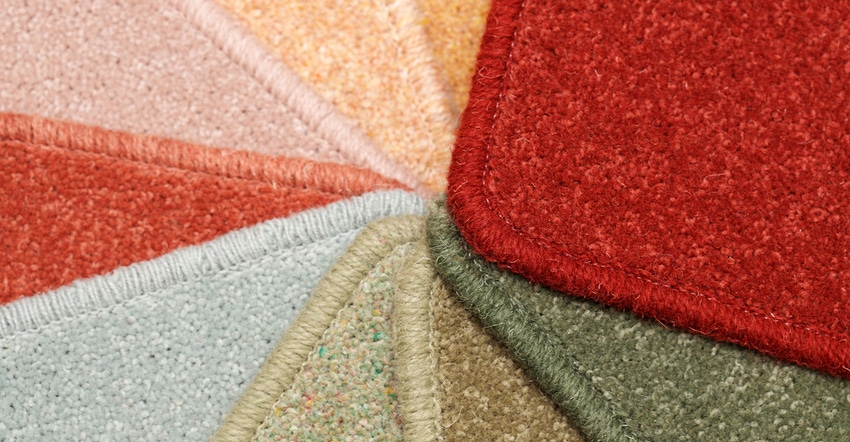Moving the Needle on Flooring Sustainability: Part Two
Heidi Sanborn, executive director of the National Stewardship Action Council, discusses California’s carpet stewardship bill, the first of its kind in the world. She tells of its shortcomings and a fix-it bill in the works to address them. Sanborn sounds the horn on a flooring category rapidly gaining market share with potential environmental ramifications.

The carpet and flooring industry has been in the limelight for its sustainability practices, and sometimes lack of such practices, for years. Part 1 of this two-part series tells some of the story of how global manufacturers Interface and Aquafil have blazed green trails and are calling on the industry as a whole to take on more responsibility for its products from cradle to grave.
In Part 2 Heidi Sanborn, executive director of the National Stewardship Action Council, discusses California’s carpet stewardship bill, the first of its kind in the world. She tells of its shortcomings and of a fix-it bill in the works to address them. Sanborn sounds the horn on a flooring category rapidly gaining market share with potential environmental ramifications.
Waste360: Brief us on the history of California’s legislation to advance carpet sustainability, including problems with the bill.
Sanborn: In 2010 California became the first jurisdiction in the world to pass carpet stewardship legislation. AB 2398 aims to increase the diversion and recycling of carpet in the state of California. It required the purchasers of carpet to pay a visible fee that was given to a carpet stewardship organization called the Carpet America Recycling Effort (CARE) to fund the management of carpet sold in California. It’s had some positive outcomes such as the State of California’s recycling rate, which, according to CARE was 33 percent in 2022 and it was determined the baseline recycling rate in California was approximately 5 percent in 2012, when the rest of the country is currently recycling approximately 4 percent, according to industry insiders.
But the foundational problem with the California stewardship program now is that it is underfunded, due to changes in the market share of carpet dropping over 20 percent over the last 12 years since the original bill passed in 2010. For context: carpet was 70 percent of flooring sold, on average, ten years ago. Now it’s under 50 percent, so the volume of carpet sold is dropping precipitously. The incoming fee attached to sales of today’s diminished carpet sales does not come close to covering the costs to responsibly manage the tremendous volume of incoming discarded carpets that were sold many years ago.
Waste360: What’s going on with engineered flooring, and what are associated concerns with these products?
Sanborn: Engineered flooring is taking a greater share of the flooring market while carpet and area rugs dropped 9.1 percent in sales in 2022 to account for only 45% of the overall flooring market in 2022. There are environmental issues with “luxury vinyl tile” (LVT), which is made of polyvinyl chloride (PVC). As Dr. Sharon George, course director in Environmental Sustainability & Green Technology, and a researcher in Keele’s Institute for Sustainable Futures states, "Vinyl is a form of plastic that is quite difficult to recycle. The C in PVC means chloride (from chlorine), which is quite toxic and difficult to handle.” (Jun 24, 2021).
We have gone from a highly recyclable product (carpets) to a product that can’t be recycled and is more toxic.
We cannot maintain the California carpet program based on sales fees only when sales are dropping. Synthetic flooring types as well as convention carpet, carpet padding, and astroturf which is also plastic, have no fee attached. We should consider covering all synthetic flooring sold today that has no end-of-life plan. The flooring industry should fund the program and design these products for recyclability. If they are not paying the end-of-life costs to manage the products, they have little reason to consider designing for recyclability.
As it stands now, we have a situation where all the financial weight of the program is placed on the most recyclable products, and the products with the lowest recycling rates, like LVT, in the U.S. are not addressed at all.
Waste360: What other states are pushing carpet stewardship bills?
Sanborn: A carpet stewardship bill passed in New York in 2023. Unfortunately, the implementation of that bill was delayed until 2026. While California’s program currently subsidizes recycling by imposing a fee on carpet sales, New York’s bill puts the responsibility on the carpet industry to develop and fund a recovery program to collect and process postconsumer carpets – and that is a pure Extended Producer Responsibility (EPR) policy and a funding mechanism we strongly prefer for a lot of reasons. The new legislation establishes mandatory goals for recycling and post-consumer content in new carpet, convenient collection statewide, education, and awareness. Additionally, manufacturers will be forbidden from making carpets treated with per- and polyfluroalkyl chemicals (PFAS) starting in January 2025, which have been linked to cancer among many other health issues. And the law will include artificial turf.
A bill was introduced in Illinois in 2022, but the carpet industry killed it. The bill would have mandated producers selling carpet in that state to implement and finance a carpet stewardship program that, among provisions, would require the industry to set up agreements to collect, transport, and process the product at the end of life.
Waste360: What do you see as answers to the funding problems with California’s carpet stewardship program?
Sanborn: Make it internalized costs instead of a consumer visible fee and add more or all synthetic flooring to the program so if consumers switch preference to other flooring types, the program is adequately funded.
Waste360: What do you see as the future for sustainable carpet policy?
Sanborn: I think carpet and synthetic flooring legislation will come up repeatedly. The carpet industry, and specifically the Carpet and Rug Institute, has worked hard to kill the bills. They have been successful in Illinois at killing a carpet stewardship bill. They were successful at getting an implementation delay in New York. In California I anticipate they will fight most of the key improvements we would like to see made to the existing program, though I think we can agree on some of the items, like adding astroturf, carpet padding, and “convention” carpets to the “covered products” list in the program.
I believe we will see stewardship bills in more states and covering more than carpet because it’s becoming clear how fast engineered flooring products are consuming the market share, and virtually none of it is recycled. I suspect states are paying attention to impacts of products and what has growing market share and is designed for disposal – that is synthetic flooring – and due to these factors, combined with the environmental issues around it, there will be assurance that it is prioritized for policy consideration.
Waste360: How do you see California policy potentially impacting industry trends beyond that state if you do?
Sanborn: California is 12 percent of the market in the U.S., so what we do with carpet and other flooring products will drive the market beyond California. Manufacturers can’t change production lines just for California and we are too big a market to just ignore. The carpet producers will likely retool their production lines to produce a product that meets California’s standards. That means all states will be offered a more eco-designed and recyclable product, but other states won’t have the added benefit of the building of the collection and recycling infrastructure.
About the Author(s)
You May Also Like




